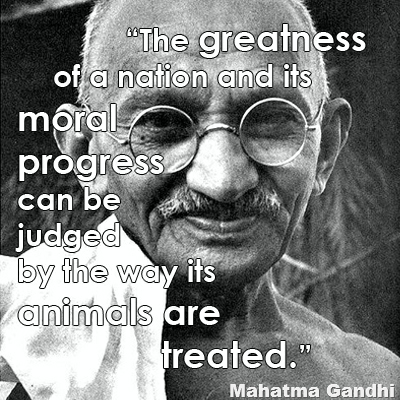Day of Reckoning: The Consequences of Yoga’s Growth in the United States (Part 2).

Read Part I of this series here.
The first two limbs of the eight limbs of Yoga are 10 fundamental precepts called the yamas and niyamas. Unlike the Ten Commandments, they are more like ethical guidelines.
The first of the yamas is ahimsa, or non-violence. The word literally means not to injure or show cruelty to any person or creature. Ahimsa is one of the major reasons many people who practice Yoga are vegetarians, seeing it as connected to the meatless path.
“The slaughter of animals obstructs the way to heaven,” says a verse in the Dharma Sutras.
More than a third of those who practice Yoga are vegetarians, according to the Yoga Site, and more than half of all Yoga teachers are vegetarians, according to Ryan Nadlonek, a Prana Flow Vinyasa Yoga teacher and journalist.
Approximately 5% of all Americans are vegetarians, and 2% are vegans, according to the latest Gallup Poll.
“A vegetarian diet is essential for one who wants to follow a spiritual life,” writes Stephen Sturgess in The Yoga Book.
Sharron Gannon, the founder of Jivamukti Yoga and an advocate of ethical vegetarianism, is even more outspoken. A core concept of Jivamukti, as articulated by her and co-founder David Life, is that understanding the ultimate connectedness of all creatures is the goal of Yoga.
Her take on eating animals is that it amounts to “enslaving, degrading, torturing, raping, and slaughtering billions of them.“
For Sharron Gannon, one of the first steps in advancing enlightenment is marrying Yoga and vegetarianism.
“If you wish to truly step into transcendental reality and have a lighter impact on the planet, adopting a compassionate vegetarian diet is a good place to start,” she writes in Yoga and Vegetarianism: The Path to Greater Health and Happiness. “Not everyone can stand on his or her head every day, but everyone eats. You can practice compassion three times a day when you sit down to eat.“
But, practicing such compassion would devastate the meat industry, shutting down innumerable farms in top livestock and poultry-slaughtering states such as Minnesota, North Carolina, and Arkansas, as well as shuttering the doors of the 6,278 federally inspected meat and poultry-processing plants in the USA.
Close to a half-million workers might be thrown out of work and their combined salaries of $19 billion lost. The effect would cascade to the suppliers, distributors, retailers, and ancillary industries that employ 6.2 million people with jobs that total $200 billion in wages.
In addition, more than $81 billion in tax revenues would be lost to federal, state, and local governments.
The meat and poultry industry contributes a total of about $832 billion to the economy, based on a 2009 study by John Dunham and Associates, or just under 6% of GDP.
Through all its various production and distribution linkages, it impacts firms in all 509 sectors of the American commercial landscape.
America’s exports would be affected, too, since in 2010 almost 7 million metric tons of meat products were shipped overseas. This would throw a monkey wrench into the USA’s balance of payments, already in the negative.
But, not only would the livestock and poultry industry be severely impacted, if not completely bankrupted, the healthcare industry would also receive another shock.
Heart disease, cancer, and stroke are the three leading causes of death in the USA. These diseases, as well as Type 2 diabetes, have all been linked to the Western diet of processed animal-based foods.
Eating red meat is associated with a significant increased risk of premature death from cancer and heart disease, according to a 26-year study published in the Archives of Internal Medicine in 2012.
“When you have these numbers in front of you, it’s pretty staggering,” said the study’s lead author, Dr Frank Hu, a professor of medicine at Harvard, referring to the strong link between red meat consumption and mortality.
The China-Cornell-Oxford Project, a 20-year study begun in 1983, one of the most comprehensive health investigations ever undertaken, concluded that these diseases, some forms of cancer among them, could almost always be prevented by eating plant-based whole foods.
If everyone in the United States practiced Yoga and vegetarianism, the healthcare industry would be dealt what might be a fatal blow.
If everyone were to turn to a plant-based diet, many of the major diseases Americans suffer from would in most likelihood be stunted.
Without the customers that make up the bulk of their work, doctors and healthcare workers would be forced to return to general practice, at a fraction of the income the major diseases now generate for them.
A further consequence of everyone in America practicing Yoga and subscribing to ahimsa, or non-violence, would be the collapse of the firearms and ammunition industry and the Department of Defense, both bulwarks of the American economy.
American companies manufacturing firearms, ammunition, and supplies for domestic use are a significant part of the country’s economy. They provide well-paying jobs and contribute substantial amounts in taxes at state and federal levels.
They employ more than 98,000 people and generate an additional 111,000 jobs in supplier and ancillary industries. These specific jobs pay an average of $46,000 in wages and benefits.
In total, the firearms and ammunition industry supports more than 986,000 jobs, says the Sporting Arms and Ammunition Manufacturer’s Institute.
In 2012, the firearms and ammunition industry was responsible for as much as $31 billion in total economic activity in the country, and paid over $2 billion in taxes including property, income, and sales-based levies, according to the National Shooting Sports Foundation.
A major trade association for the firearms industry, the National Shooting Sports Foundation represents more than 7,000 manufacturers, distributors, retailers, and organizations. They are located in Newtown, Connecticut.
Parenthetically, in December 2012, in Newtown, Connecticut, a young man wielding several legally purchased high-powered weapons massacred 26 people, among them 20 children at an elementary school.
In the past two years, amid difficult economic times and high unemployment rates nationally, the firearms and ammunition industry created over 26,000 new jobs.
“Our industry is proud to be one of the bright spots in the economy,” noted the National Shooting Sports Foundation in its Impact Report 2012.
Hunting and target shooting activities employ more people than Chrysler, Philip Morris, UPS, and Ford, combined. The economic activity generated by the hunting and shooting industries exceed the annual sales of most Fortune 500 companies.
The consequences of a nationwide yogic adoption of the principle of non-violence would have multiple, ripple effects.
For one thing, although here are currently more than 300 million guns currently in circulation in the USA, a widespread belief in non-violence would mean far fewer people getting shot than are currently being shot in our times.
For example, in 2008 there were 39 fatalities from crimes involving firearms in England and Wales, where all handguns and automatic weapons have been effectively banned. The population of the United States is approximately 6 times that of England and Wales.
By comparison, in the United States, there were 12,000 gun-related homicides in 2008, or 307 times as many.
Every year in the USA, there are more than 100,000 deliberate or accidental gunshot injuries, and more than 30,000 gun-related deaths, every one of them treated at emergency rooms and hospitals.
The costs for these shootings run into the hundreds of millions of dollars, and as a line item represent a profit center for the healthcare industry. If shootings were largely eliminated from the American landscape, the healthcare industry would be adversely impacted in terms of its bottom line.
Of greater impact would be the jobs and industries lost.
It is no exaggeration to suppose that more than $30 billion a year could and would be drained from the American economy, affecting the wallets of workers, the stock of publicly traded companies, and the coffers of government, from the local to national level.
If everyone practiced Yoga and the attendant yama of non-violence, the intense debates over gun-control laws, which never seem to change very much, would cease to be relevant, or irrelevant, whichever may be the case.
Another victim of a widespread adoption of non-violence would be the elephant in the room, the Department of Defense, a $900 billion business. The Defense Department is America’s largest employer with over 1.4 million active duty and 720,000 civilian personnel.
More than 450,000 employees are stationed overseas in 163 countries. Nearly 3 million people receive income from the Defense Department, either as National Guard or veterans and their families.
Over half of the discretionary expenditure in the American budget goes to the Defense Department.
If the Department of Defense were to lay down its sword, the ranks of the unemployed would increase by more than 25% overnight, throwing the country into another instant recession, if not a depression.
It is instructive that among economists the common thought is that the Great Depression was resolved not because of the New Deal, but with the advent of World War II.
It is clear that an ethos of non-violence could be a death knell for the American dream, closing innumerable factories, throwing millions of people out of work, and extracting hundreds of billions of dollars annually from the economy.
It might also shake America to its core, splitting the bedrock upon which it is built.
*****
Coming Next: Yoga’s Threat to the Underpinnings of the West.

